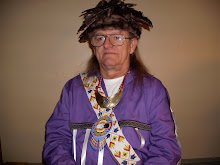Upon their arrival, the Pilgrims were befriended by several natives, among them Samoset, Squanto, Massasoit and Hobomok.
Samoset was the first. He came to the settlers in March of 1621. His boldness surprised them, but not as much as his ability to speak the English language. Samoset said he was an Algonquin Sagamore from what is now the vicinity of Pemaquid Point, Maine. In a short time, he told the Pilgrims about the country around them, its land and people, and the political situation. He also introduced the colonists to another English speaking Indian. Tisquantum or Squanto. With Squanto, Samoset introduced the settlers to the Chief of the Wampanoags, Massasoit. He was also present at the signing of the treaty between the Wampanoags and the English. Soon after this he returned to his native lands, leaving Squanto to continue with the Pilgrims.
Squanto had learned English during his captivity aboard a slave ship bound for Spain. He escaped, making his way to England where he was in the care of an English merchant for a time. Eventually he made his way back to the Americas and his native Patuxet, now Plymouth, only to find himself the sole survivor of a plague-struck town. Squanto helped to make the peace treaty between the English and the Indians, living with them until he died of a fever late in 1622. He taught the settlers how to fish, plant Indian corn and make a profit from the land.
After the signing of the peace treaty, another native, Hobomok, served as a vital link between the settlers and the Wampanoags. Hobomok was a man of good standing. His people calledhim Prise, which meant he was an advisor in councel and could lead war parties. Hobomok's job in Plymouth was to make sure the treaty conditions were adhered to by both sides. His house was situated on what is now called Watson's Hill between Pilgrim John Howland and Stephen Hopkins fields. Hobomok lived here with his several wives and children until, as tradition tells it, he and his family moved to Duxbury with Captain Standish, living there until his death. Hobomok was concidered to be among the first natives to accept Christianity. During one of the drought years, he is believed to have observed the Pilgrims praying for rain on a day that was bright and sunny with no clouds in sight. During the course of their prayers, the clouds began to rise and eventually the rain did fall"in a most sweet, constant soaking shower." He was amazed at the power of the English God and pledged from that day forward his loyality to the English and to their God. Despite the scorns of his own people, he continued in his Christian beliefs until the time of his death, sometime before 1643. As recorded from Town records in Plymouth, MA.

No comments:
Post a Comment